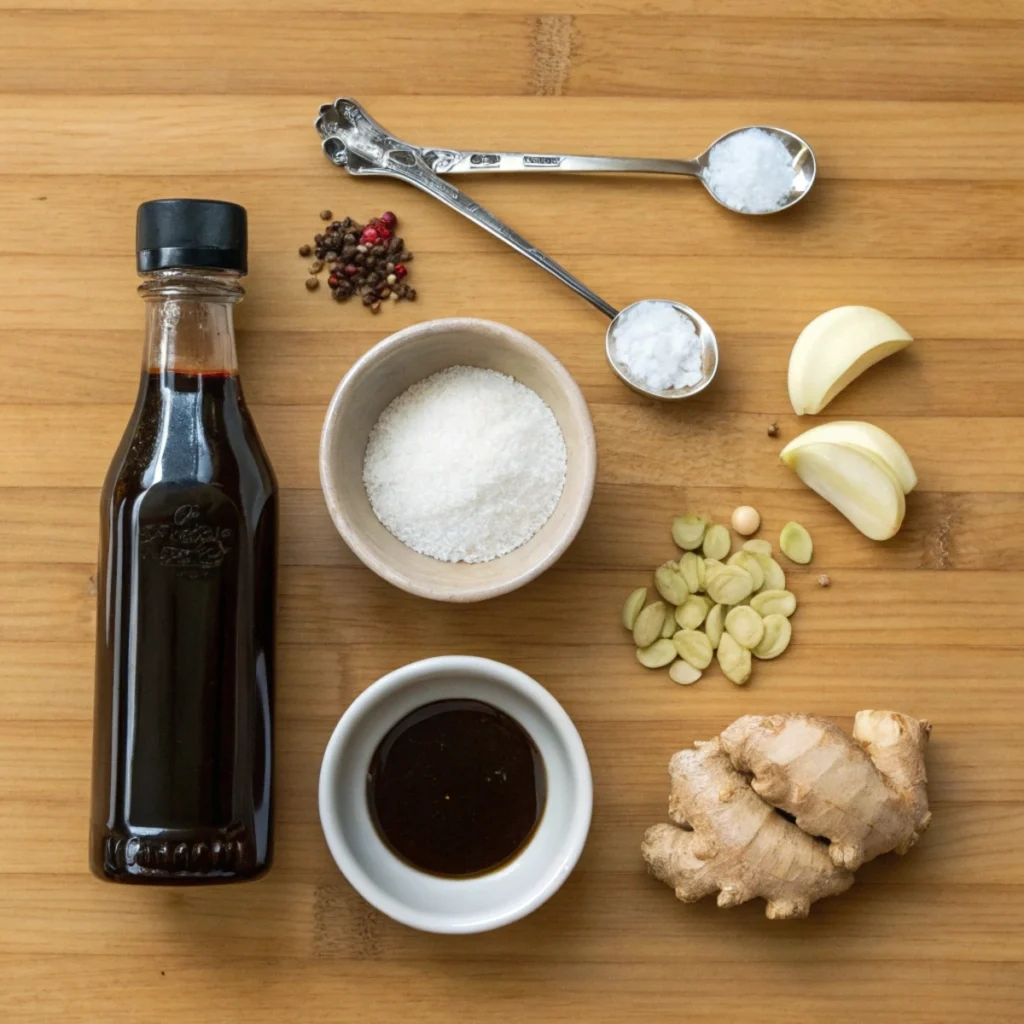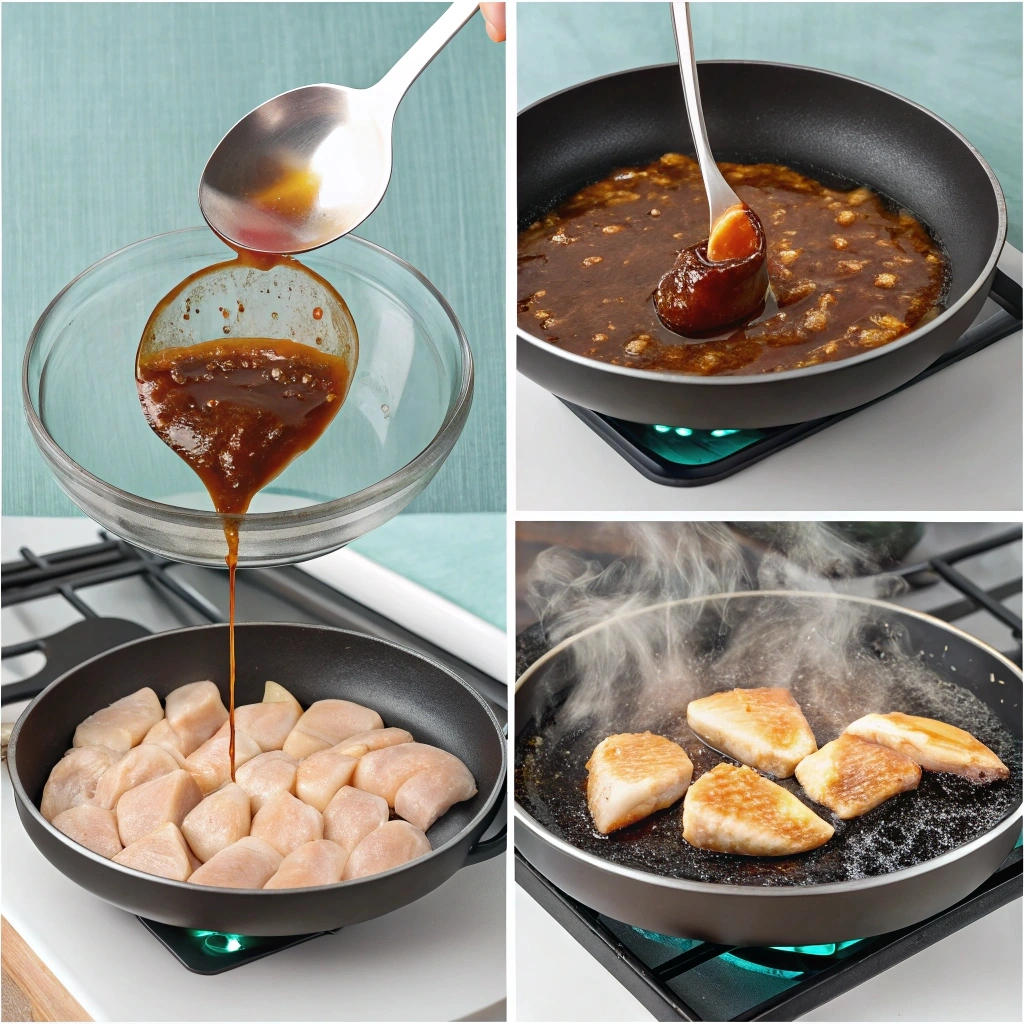Introduction
Teriyaki chicken is a beloved dish that has gained worldwide fame for its irresistible combination of sweet, savory, and umami flavors. Whether served over a bed of fluffy rice or alongside steamed vegetables, this dish is a crowd-pleaser for all ages. Rooted in Japanese cuisine, teriyaki chicken offers a harmonious balance of flavors, making it a staple in homes and restaurants alike.
In this ultimate guide, we’ll dive deep into the taste, ingredients, and cooking techniques that make teriyaki chicken a standout dish. From understanding what gives it its unique flavor to exploring its global variations, this article is your one-stop resource for all things teriyaki chicken.
Let’s begin by exploring the fundamentals: what exactly is teriyaki chicken, and why is it so special?
Table of Contents
What Is Teriyaki Chicken?
Understanding Teriyaki Cuisine
Teriyaki is a traditional Japanese cooking technique that involves grilling or broiling meat, fish, or vegetables while basting them in a glossy, flavorful sauce. The term “teriyaki” comes from the Japanese words teri (shine or luster) and yaki (grill or broil). The “shine” refers to the glossy glaze that characterizes teriyaki dishes, achieved through the careful blending of soy sauce, sugar, and mirin.
Teriyaki chicken is a quintessential dish in Japanese cuisine, featuring succulent pieces of chicken coated in a sweet and savory sauce. Its appeal lies in its simplicity, versatility, and ability to adapt to different palates. While traditionally grilled, teriyaki chicken can also be pan-fried or baked, offering flexibility in preparation methods.
The Origin and Popularity of Teriyaki Chicken
Although teriyaki originated in Japan, the dish gained significant traction globally, particularly in the United States, through the influence of Japanese immigrants. Today, it is a popular menu item in restaurants worldwide, often customized with local flavors and ingredients.
One reason for its widespread appeal is its adaptability. Teriyaki chicken can be served as a main course, used in sandwiches or wraps, or even added as a topping for sushi and salads. Its unique flavor profile, combining sweetness with a hint of saltiness, makes it a favorite among food lovers everywhere.
Teriyaki chicken’s rich history and delectable taste ensure it remains a timeless culinary delight.
What Does Teriyaki Chicken Taste Like?
The Sweet and Savory Flavor Profile
Teriyaki chicken is renowned for its harmonious blend of sweet, savory, and umami flavors. The sweetness comes from sugar or honey in the sauce, perfectly balanced by the saltiness of soy sauce. Together, these elements create a rich, caramelized glaze that clings to the chicken, adding both flavor and texture.
In addition to its core sweet-savory base, teriyaki sauce often includes a hint of acidity from rice vinegar or mirin, lending a subtle tang that cuts through the richness. The combination is further elevated by the umami notes from soy sauce and sometimes sesame oil, making every bite deeply satisfying.
Key Ingredients Contributing to the Unique Taste

The taste of teriyaki chicken relies heavily on its ingredients. Here’s a breakdown of the essential components:
- Soy Sauce: Provides the salty, umami base of the sauce.
- Sugar or Honey: Adds the sweetness that balances the saltiness.
- Ginger and Garlic: Often added for depth and a hint of spice.
- Mirin or Sake: Contributes a mild tang and enhances the glaze’s shine.
When cooked, the sauce caramelizes on the surface of the chicken, creating a slightly sticky texture that’s both indulgent and flavorful. The chicken itself, tender and juicy, soaks up the sauce, ensuring that every bite is bursting with flavor.
Whether you enjoy teriyaki chicken on its own or paired with rice and vegetables, its unmistakable taste is what keeps people coming back for more.
What’s in Teriyaki Sauce? Ingredients Breakdown
Core Ingredients of Traditional Teriyaki Sauce
The magic of teriyaki chicken lies in its sauce, a perfect blend of sweet, salty, and tangy flavors. Traditional teriyaki sauce includes simple yet essential ingredients that work together to create its signature taste. Here’s a closer look:
- Soy Sauce:
- The foundation of teriyaki sauce, soy sauce adds a deep, salty, and umami-rich flavor. It’s the key ingredient that ties everything together.
- Sugar or Honey:
- Sweetness is a hallmark of teriyaki sauce, and sugar or honey delivers the perfect balance to the saltiness of the soy sauce.
- Mirin or Sake:
- Mirin, a sweet Japanese rice wine, or sake is used to enhance the depth and complexity of the sauce. It also contributes to the glossy finish.
- Ginger:
- Freshly grated ginger provides a warm, spicy undertone that balances the sweetness.
- Garlic:
- Minced garlic adds another layer of flavor, giving the sauce a savory kick.
Variations: Homemade vs. Store-Bought Teriyaki Sauce
While traditional teriyaki sauce is simple to prepare, store-bought options often include additional ingredients to extend shelf life or cater to different tastes. Let’s compare the two:
- Homemade Teriyaki Sauce:
- Fresh and customizable, allowing you to adjust the sweetness, saltiness, or thickness. You can also add ingredients like sesame oil or chili flakes for a personal touch.
- Store-Bought Teriyaki Sauce:
- Convenient and widely available, but often includes preservatives and additives. Some brands may use cornstarch or thickening agents to alter the sauce’s consistency.
Why the Ingredients Matter
Each ingredient in teriyaki sauce plays a crucial role in creating its unique taste and texture. Whether you prefer a classic homemade version or a quick store-bought alternative, understanding these ingredients will help you choose or craft the best sauce for your teriyaki chicken.
Is Teriyaki Made with Chicken or Pork?
Traditional Meat Choices in Teriyaki Cuisine
Teriyaki is a versatile cooking technique that traditionally features a variety of proteins, including chicken, fish, and pork. In Japanese cuisine, chicken (tori) is one of the most popular choices for teriyaki due to its mild flavor and ability to absorb the rich sauce. Chicken thighs are often used for their tender and juicy texture, though chicken breasts are also common for a leaner option.
Pork is another classic protein used in teriyaki, especially in Japan. Cuts like pork belly or loin are preferred because they hold up well during grilling or pan-frying and develop a beautiful caramelized glaze when coated in teriyaki sauce.
Global Adaptations and Modern Protein Options
As teriyaki became a global sensation, chefs and home cooks began experimenting with different proteins, leading to a variety of teriyaki dishes worldwide. Here are some common variations:
- Chicken Teriyaki:
- The most widely recognized version, chicken teriyaki is a staple in Japanese restaurants and home kitchens alike.
- Pork Teriyaki:
- While less common outside Japan, pork teriyaki delivers a richer flavor profile due to the fattiness of the meat.
- Beef Teriyaki:
- A popular Western adaptation, beef teriyaki is often made with tender cuts like sirloin or ribeye.
- Seafood Teriyaki:
- Salmon, shrimp, and scallops are frequently used, offering a lighter option with the same bold flavors.
Chicken vs. Pork: What’s More Popular?
While both chicken and pork are excellent choices, chicken teriyaki reigns as the most popular version globally, thanks to its mild taste and widespread availability. However, pork teriyaki remains a traditional favorite in Japan, prized for its rich and savory flavor.
Is Teriyaki Sauce Runny or Thick?
The Ideal Consistency of Teriyaki Sauce
Teriyaki sauce can range from slightly runny to moderately thick, depending on its preparation and intended use. Traditionally, teriyaki sauce has a glossy, pourable consistency that clings to food without being overly thick. This allows it to coat chicken, fish, or vegetables evenly while still penetrating the surface for added flavor.
The consistency of the sauce is achieved by balancing liquid ingredients like soy sauce and mirin with sugar or honey, which naturally thicken the sauce when heated. Some recipes also use cornstarch or flour to achieve a thicker texture, especially for dipping sauces or marinades.
Tips to Thicken or Thin Teriyaki Sauce at Home
If you’re preparing teriyaki sauce at home, you can easily adjust its consistency to suit your preference:
- To Thicken the Sauce:
- Simmering Longer: Cooking the sauce over low heat allows the water to evaporate, concentrating the flavors and naturally thickening it.
- Cornstarch Slurry: Mix one tablespoon of cornstarch with two tablespoons of water, then stir it into the simmering sauce. This method is quick and effective.
- Honey or Brown Sugar: Adding more sweeteners can thicken the sauce while enhancing its caramelized flavor.
- To Thin the Sauce:
- Add Liquid: Incorporate a small amount of water, chicken broth, or extra soy sauce to dilute the sauce without compromising its taste.
- Control Heat: Avoid over-reducing the sauce during cooking if you prefer a runnier consistency.
What to Aim For?
For teriyaki chicken, a slightly thick sauce that clings to the meat is ideal, creating a delicious glaze. For dipping or drizzling, a thinner sauce is more practical. Adjust the consistency based on how you plan to use it!
Is Teriyaki Sauce Halal?
Examining the Ingredients for Halal Suitability
Teriyaki sauce can be halal, but its status depends on the ingredients used. Traditional teriyaki sauce is typically made with soy sauce, sugar, mirin, and other seasonings like garlic and ginger. However, certain ingredients, like mirin and sake, are forms of rice wine, which contain alcohol and are not considered halal in Islamic dietary laws.
Here’s a breakdown of potential halal and non-halal components:
- Halal Ingredients:
- Soy sauce (if alcohol-free)
- Sugar or honey
- Garlic, ginger, and other spices
- Non-Halal Ingredients:
- Mirin or Sake: Both are alcoholic rice wines traditionally used in Japanese cooking.
- Alcoholic Soy Sauce: Some soy sauces may contain a small amount of alcohol as a by-product of fermentation.
How to Make or Purchase Halal-Friendly Teriyaki Sauce
If you’re preparing or buying teriyaki sauce and need it to be halal, here’s what you can do:
- Homemade Halal Teriyaki Sauce:
- Replace mirin or sake with non-alcoholic alternatives like rice vinegar, apple cider vinegar, or grape juice for a similar tangy flavor.
- Ensure the soy sauce is labeled “alcohol-free” or certified halal.
- Halal Store-Bought Options:
- Look for sauces that are clearly labeled as halal-certified. Many brands cater to halal dietary restrictions by avoiding alcohol and using alternative ingredients.
What to Look For?
Always check ingredient labels for alcohol or non-halal components. By substituting or avoiding certain ingredients, you can enjoy a halal-friendly teriyaki chicken dish that retains all the delicious flavors of the original.
Looking for more ways to cook with chicken? Visit our Chicken Recipes for ideas like baked, fried, or grilled chicken dishes
Is Teriyaki Spicy to Eat?

The Mild Flavor of Classic Teriyaki Sauce
Traditional teriyaki sauce is not spicy. It’s designed to be a sweet and savory glaze with rich umami flavors, making it suitable for a wide range of palates, including children and those who prefer mild dishes. Ingredients like soy sauce, sugar, mirin, and ginger create a well-rounded taste without any heat.
This mildness is one of the reasons why teriyaki chicken is so popular—it’s versatile and pairs well with a variety of side dishes without overpowering them.
Adding Spice: Variations for Heat Lovers
While classic teriyaki sauce is not spicy, it can easily be adapted to include some heat for those who enjoy a little kick. Here are some popular ways to spice up teriyaki sauce:
- Chili Flakes or Powder:
- Sprinkle red chili flakes or a pinch of cayenne pepper into the sauce during cooking for a subtle, warming heat.
- Sriracha or Hot Sauce:
- Mix in a few drops of your favorite hot sauce, like sriracha, for a tangy, spicy twist.
- Fresh Chili Peppers:
- Add thinly sliced fresh chilies, like red Thai chilies or jalapeños, for an extra burst of spice and color.
- Gochujang:
- Incorporate this Korean fermented chili paste to create a fusion of teriyaki and spicy Korean flavors.
Customizing to Your Taste
The beauty of teriyaki chicken lies in its adaptability. Whether you prefer it mild and kid-friendly or with a fiery kick, you can easily adjust the spice level to suit your taste. For family meals, you can even serve the traditional mild version and offer a spicy sauce on the side.
How to Cook Teriyaki Chicken at Home
Essential Ingredients for Homemade Teriyaki Chicken
Making teriyaki chicken at home is surprisingly simple, requiring just a few key ingredients that you may already have in your pantry. Here’s what you’ll need:
- Chicken:
- Choose boneless, skinless chicken thighs for a tender, juicy texture, or chicken breasts for a leaner option.
- Teriyaki Sauce Ingredients:
- Soy Sauce: The foundation of the sauce.
- Sugar or Honey: Adds sweetness.
- Mirin or Vinegar: Enhances flavor and provides a slight tang.
- Garlic and Ginger: Freshly minced for depth and aroma.
- Optional Additions: Sesame oil for nuttiness or cornstarch for thickening.
- Vegetable Oil:
- For pan-frying the chicken to golden perfection.
Step-by-Step Cooking Instructions
- Prepare the Chicken:
- Rinse and pat dry the chicken. Cut it into bite-sized pieces or leave it whole, depending on your preference.
- Make the Teriyaki Sauce:
- In a small bowl, whisk together soy sauce, sugar or honey, minced garlic, grated ginger, and mirin (or vinegar). For a thicker sauce, add a teaspoon of cornstarch mixed with water.
- Cook the Chicken:
- Heat a tablespoon of vegetable oil in a pan over medium heat. Add the chicken and cook until browned on both sides, about 4-5 minutes per side.
- Add the Sauce:
- Pour the teriyaki sauce over the chicken. Let it simmer for 5-7 minutes, occasionally stirring, until the sauce thickens and coats the chicken evenly.
- Serve:
- Garnish with sesame seeds and chopped green onions. Serve over steamed rice with a side of vegetables for a complete meal.
Pro Tip:
For a smoky, grilled flavor, you can cook the chicken on a grill or in a broiler, brushing the sauce over the meat during the final minutes of cooking.
Serving Suggestions and Side Dishes
Popular Side Dishes for Teriyaki Chicken
Teriyaki chicken is a versatile dish that pairs beautifully with a variety of side dishes. Whether you’re aiming for a traditional Japanese meal or something more fusion-inspired, these options are guaranteed to complement your teriyaki chicken:
- Steamed Rice:
- The classic pairing, steamed white or brown rice, absorbs the flavorful teriyaki sauce, making each bite more satisfying.
- Fried Rice:
- For a flavorful twist, serve teriyaki chicken with vegetable fried rice or egg fried rice.
- Stir-Fried Vegetables:
- Crisp and colorful veggies like broccoli, bell peppers, carrots, and snap peas add a fresh crunch to balance the rich teriyaki sauce.
- Japanese Salad:
- A light cucumber and sesame salad or seaweed salad adds a refreshing element to your meal.
- Miso Soup:
- This traditional soup pairs well with teriyaki chicken, providing a warm and comforting side.
- Noodles:
- Serve teriyaki chicken with soba, udon, or ramen noodles tossed in sesame oil and soy sauce for a hearty, satisfying option.
Plating and Presentation Tips for a Japanese Experience
To create an authentic Japanese dining experience, consider these plating tips:
- Use a Bento Box or Plate:
- Arrange the teriyaki chicken, rice, and side dishes in separate sections for a visually appealing meal.
- Garnish with Sesame Seeds and Green Onions:
- A sprinkle of sesame seeds and freshly chopped green onions adds flavor and aesthetic appeal.
- Serve with Chopsticks:
- For authenticity, use chopsticks and a small dipping bowl for extra teriyaki sauce.
Pairing with Drinks:
Complete your meal with traditional beverages like green tea or sake. For a non-alcoholic option, a refreshing glass of iced matcha works perfectly.
FAQ About Teriyaki Chicken
1. What Does Chicken Teriyaki Taste Like?
Chicken teriyaki has a sweet, savory, and umami-rich flavor profile. The glaze is caramelized and slightly sticky, clinging to the chicken for a perfect balance of saltiness from soy sauce and sweetness from sugar or honey. It’s a crowd-pleaser that appeals to all age groups.
2. What’s in Teriyaki Sauce Ingredients?
Traditional teriyaki sauce is made with:
- Soy sauce (providing saltiness and umami)
- Sugar or honey (adding sweetness)
- Mirin or sake (for tanginess and a glossy finish)
- Fresh garlic and ginger (for depth and aroma)
Variations may include sesame oil, cornstarch (for thickening), or chili flakes for a spicy twist.
3. Is Teriyaki Chicken or Pork?
Traditionally, teriyaki can be made with chicken, pork, beef, or seafood. Chicken is the most popular version worldwide because of its mild flavor and versatility. Pork, while less common outside Japan, is a traditional favorite for its rich taste and tenderness.
4. Is Teriyaki Sauce Runny or Thick?
Teriyaki sauce can vary in consistency. It’s usually slightly thick but pourable, designed to coat meats and vegetables evenly. Homemade versions can be thickened with cornstarch or simmered to reduce. Store-bought versions often have a thicker, syrupy texture.
5. Is Teriyaki Sauce Halal?
Teriyaki sauce can be halal if it excludes alcohol-based ingredients like mirin or sake. Substituting rice vinegar or grape juice for mirin ensures it remains halal-friendly. Always check labels or make your own for complete control over ingredients.
6. Is Teriyaki Spicy to Eat?
Classic teriyaki sauce is not spicy. It’s known for its mild, sweet, and savory flavor. However, you can easily add spice by incorporating chili flakes, hot sauce, or fresh chilies into the sauce for a spicier variation.
Conclusion
Teriyaki chicken is a timeless dish that brings together the perfect blend of sweet, savory, and umami flavors. Its versatility, ease of preparation, and adaptability to various dietary preferences have made it a global favorite. Whether you’re enjoying it with a bowl of rice, paired with fresh vegetables, or adding a spicy kick for a twist, teriyaki chicken is a recipe that never disappoints.
By understanding the origins, ingredients, and cooking methods, you can now recreate this Japanese classic in your own kitchen with confidence. Plus, with the guidance provided, you can customize it to suit your tastes, dietary needs, and even cultural preferences.
Ready to elevate your cooking game? Dive into teriyaki chicken recipes, explore new side dishes, and share this flavorful dish with your family and friends. Don’t forget to experiment with homemade teriyaki sauce to make it uniquely yours!
Ready to elevate your cooking game? Check out more amazing recipes on our Home Page today!


